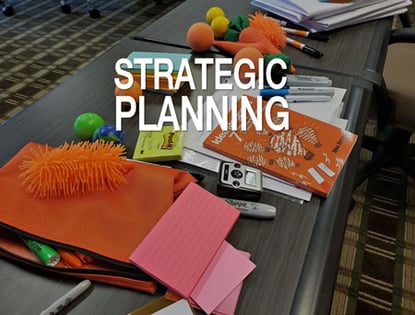In the past few weeks, we've had several discussions with potential clients about facilitating their strategic planning processes for next year.
In each of the calls, we've discussed the concept of "producing strategic conversations."
Producing Strategic Conversations?
 The phrase, "producing strategic conversations," actually predates the creation of The Brainzooming Group.
The phrase, "producing strategic conversations," actually predates the creation of The Brainzooming Group.
We started using it to describe what we were doing internally in a Fortune 500 setting. It was an apt description of how we were helping marketing managers and senior leaders quickly (as in one day) explore, articulate, and document their strategic plans. We delivered this efficiency by avoiding a typical strategic planning approach: handing participants a slew of confusing or vague planning templates and expecting them to complete the templates on their own.
Instead, we were creating strategic impact by leading them through creative structures and strategic thinking exercises. These exercises helped them efficiently and actively explore and discuss opportunities and challenges in new ways within groups of their internal collaborators. We captured the details and themes emerging from the "strategic conversations," using the output to document plans within a very brief time frame.
It was during hundreds of these sessions (many conducted in the hotel meeting room shown here) that we honed the Brainzooming methodology.
Facilitating a Strategic Conversation
In terms of facilitating strategic conversations, it's not the typical facilitation used in a market research or focus group setting, although that might be what it resembles.
Instead, we facilitate in a style that both encourages and challenges participants. To put it in a sports setting, we act as both cheerleaders and tough coaches. All the while, we earn and honor the trust that allows us to move back and forth between these two contrasting roles.
Specific fundamentals we employ in producing a stimulating strategic conversation include:
- Demonstrating sincere excitement for participants' contribution
- Not letting a participant flounder when trying to contribute (esp. when just starting to share ideas)
- Making only productive interruptions, i.e., those that help guide them and draw out additional comments
- Physically leaning in to the discussion to signal interest and anticipation for what participants have to say
- Smiling as a way to demonstrate our connection with a participant
Again, the differences are subtle relative to typical facilitation. But coupled with the wide depth and variety of tested strategic thinking exercises we bring to the table, it works very differently, and it works wonders.
Are you thinking about next year's planning yet?
If you're already thinking about next year (and we know SOME of you are) and would like to get a huge head start that will even benefit your current year results, give us a call or email. Let’s see how we can work together.
Now is definitely the time to get started! – Mike Brown
If you enjoyed this article, subscribe to the free Brainzooming email updates.
The Brainzooming Group helps make smart organizations more successful by rapidly expanding their strategic options and creating innovative plans they can efficiently implement. Email us at info@brainzooming.com or call us at 816-509-5320 to learn how we can help you enhance your strategy and implementation efforts.




